Reckitt Benckiser Group Bundle
Who Truly Owns Reckitt Benckiser?
Ever wondered about the forces steering the global consumer goods giant, Reckitt Benckiser (RB Group)? Understanding Reckitt Benckiser Group SWOT Analysis is paramount for investors and strategists alike. From its humble beginnings to its current status, the company's ownership structure has evolved significantly, shaping its market position and future prospects. Discover the key players and pivotal moments that define Reckitt ownership.
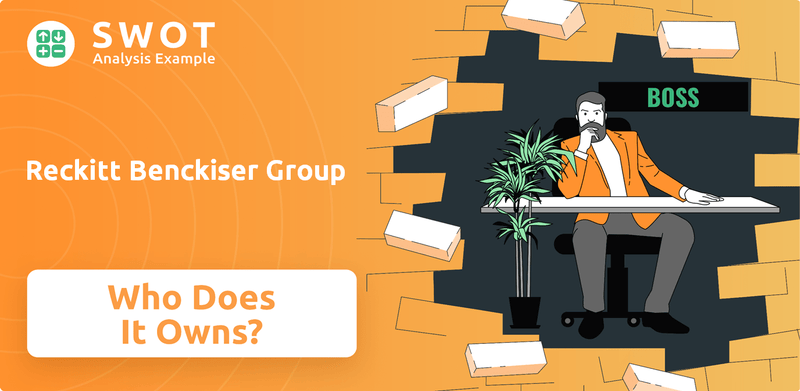
This exploration into Reckitt Benckiser's ownership will unveil the influence of major shareholders and the impact of strategic decisions, such as divestitures, on the company's trajectory. We'll examine the company's structure, including its headquarters location and the diverse portfolio of brands it manages, to provide a comprehensive understanding of this leading consumer health and hygiene company. Gaining insights into who owns RB Group is essential for anyone looking to understand its financial performance and market share, including its competitors and subsidiaries.
Who Founded Reckitt Benckiser Group?
The history of Reckitt Benckiser (RB Group) begins with the independent ventures of its predecessor companies. The evolution of Reckitt ownership reflects a transition from family-run businesses to a publicly traded multinational corporation.
Isaac Reckitt founded Reckitt & Sons in 1840, and Johann Benckiser established a business in 1823. Jeremiah Colman founded J&J Colman in 1814. These companies, each with their own distinct origins, eventually merged to form the modern entity.
The journey of Reckitt Benckiser from its founding to its current structure involved strategic mergers and public listings, shaping its ownership over time. The company's structure and ownership have evolved significantly since its inception.
Isaac Reckitt started Reckitt & Sons in 1840 in Hull, England, initially renting a starch mill. After Isaac's death in 1862, his three sons took over the business. Reckitt & Sons was first listed on the London Stock Exchange in 1888.
Johann Benckiser established a business in Pforzheim, Germany, in 1823, focusing on industrial chemicals. Chemist Ludwig Reimann joined in 1828 and later took ownership. This business was a key part of the future merger.
Jeremiah Colman founded J&J Colman in 1814 in Norwich, England. They began milling flour and mustard. This company was another essential piece of the merger puzzle.
In 1938, Reckitt & Sons merged with J&J Colman to form Reckitt & Colman Ltd. This merger was a significant step in the company's evolution. The merger brought together two established businesses.
Benckiser N.V. went public in 1997. This was a crucial step before the final merger. The public listing allowed for broader investment.
The final merger created the modern entity. Early agreements shaped control, but details are not widely publicized. The founding teams' visions drove growth.
While specific details on early shareholding percentages are not readily available, the progression from family-owned businesses to public listings indicates a gradual broadening of company ownership. The evolution of the company's structure is a testament to its growth and strategic decisions over time. For more insights, consider exploring the Competitors Landscape of Reckitt Benckiser Group.
Reckitt Benckiser Group SWOT Analysis
- Complete SWOT Breakdown
- Fully Customizable
- Editable in Excel & Word
- Professional Formatting
- Investor-Ready Format
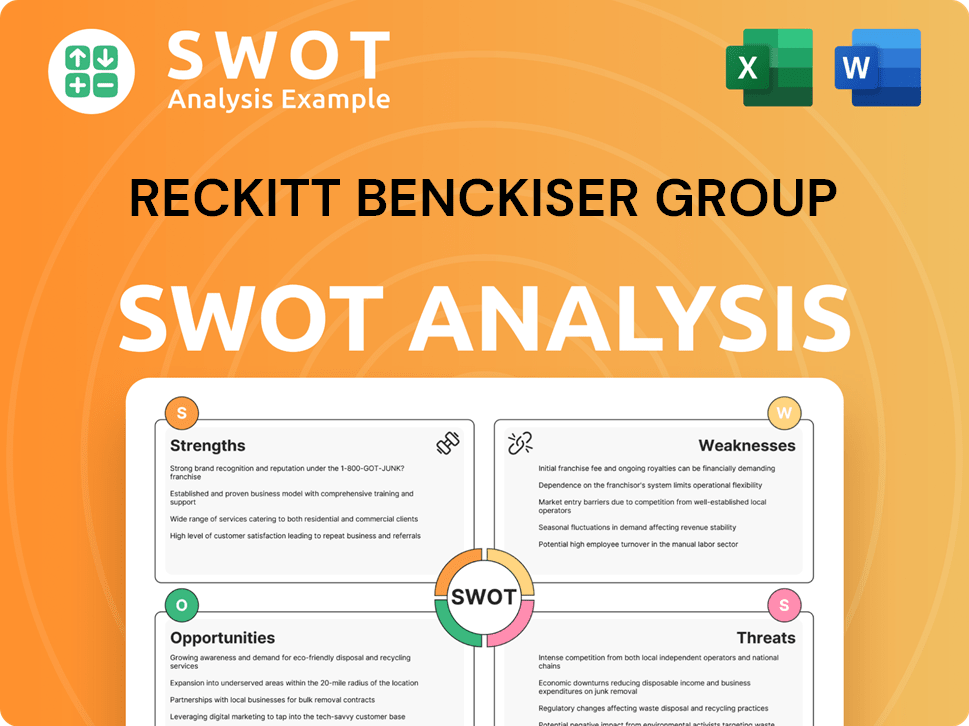
How Has Reckitt Benckiser Group’s Ownership Changed Over Time?
The most significant shift in Reckitt Benckiser Group's ownership structure occurred in December 1999, with the merger of Reckitt & Colman plc and Benckiser N.V. This merger created the foundation for the current entity. The company's listing on the London Stock Exchange on October 23, 2007, marked a crucial step, transforming it into a publicly traded entity, thereby broadening its ownership base to include institutional and individual investors.
As of June 13, 2025, the market capitalization of Reckitt Benckiser Group (RB Group) stood at approximately £35.1 billion ($47.2 billion). This valuation reflects the company's size and market position, influencing the distribution of its shares among various investors. The company's Annual Report and Financial Statements, published on March 26, 2025, provides detailed insights for stakeholders regarding financial performance and ownership-related information.
| Key Dates | Event | Impact on Ownership |
|---|---|---|
| December 1999 | Merger of Reckitt & Colman plc and Benckiser N.V. | Formation of Reckitt Benckiser Group, setting the stage for future ownership structure. |
| October 23, 2007 | Listing on the London Stock Exchange | Transition to a publicly traded company, broadening the shareholder base. |
| July 2024 - June 2025 | Share Buyback Program | Reduction in outstanding shares, potentially increasing the proportional ownership of existing shareholders. |
Reckitt has actively engaged in share buyback programs, which have a direct impact on the ownership percentages of existing shareholders. For example, in July 2024, a £1 billion share buyback program was announced. As of April 17, 2025, a total of £815 million of shares had been repurchased. These buybacks reduce the total number of outstanding shares. As of June 12, 2025, the company held 56,613,731 ordinary shares in treasury, with 679,921,448 ordinary shares in issue (excluding treasury shares), impacting total voting rights.
Reckitt Benckiser (RB Group) is a publicly traded company, with ownership spread across various institutional investors and individual shareholders. The company's ownership structure has evolved significantly, particularly with mergers and listings on stock exchanges.
- The primary owners are institutional investors.
- Share buyback programs impact the number of outstanding shares.
- The company's market capitalization is approximately £35.1 billion ($47.2 billion) as of June 13, 2025.
- The 2024 Annual Report and Financial Statements were published on March 26, 2025.
Reckitt Benckiser Group PESTLE Analysis
- Covers All 6 PESTLE Categories
- No Research Needed – Save Hours of Work
- Built by Experts, Trusted by Consultants
- Instant Download, Ready to Use
- 100% Editable, Fully Customizable
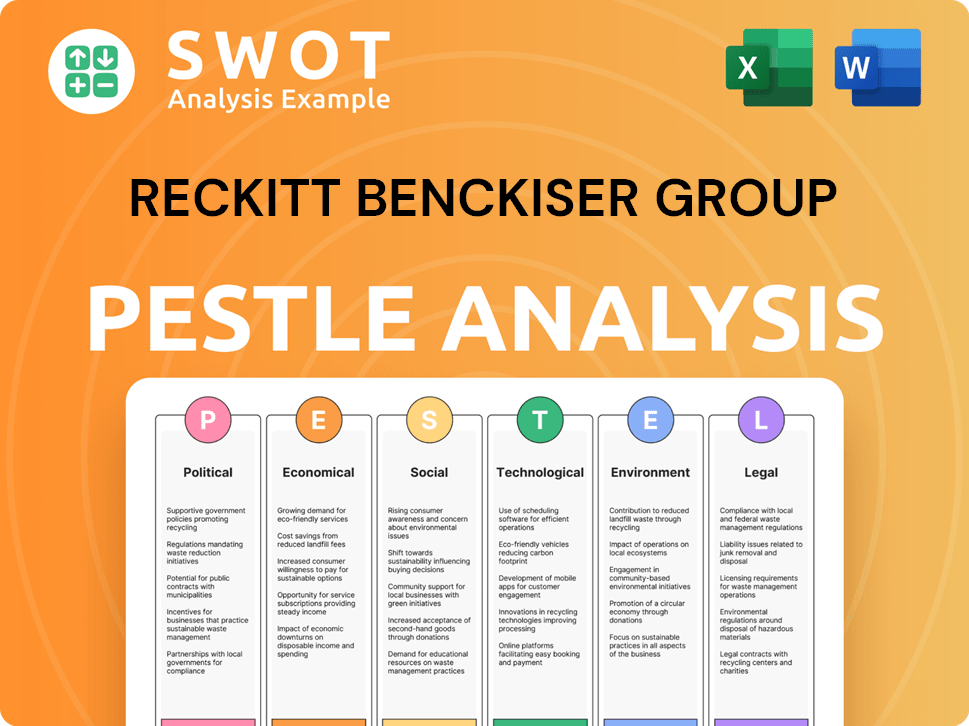
Who Sits on Reckitt Benckiser Group’s Board?
The current Board of Directors at Reckitt Benckiser (RB Group) plays a key role in the company's governance. Sir Jeremy Darroch serves as the Non-Executive Independent Chairman, appointed in May 2024. Kris Licht is the Chief Executive Officer and an Executive Director, having been appointed in May 2023. Shannon Eisenhardt became the Chief Financial Officer and an Executive Director in March 2024. This structure ensures a balance of executive and non-executive perspectives in the company's strategic decisions.
The board includes several non-executive directors, such as Mahesh Madhavan and Stefan Oschmann, who joined on January 1, 2025. Marybeth Hays was appointed as a non-executive director in January 2024. Other non-executive directors include Fiona Dawson, Patricia Verduin, Andrew Robert John Bonfield, and Margherita Della Valle. Mary Harris was reappointed as Chair of the Remuneration Committee until the 2025 AGM. This composition ensures diverse expertise and oversight of Reckitt ownership.
| Director | Role | Appointment Date |
|---|---|---|
| Sir Jeremy Darroch | Non-Executive Independent Chairman | May 2024 |
| Kris Licht | Chief Executive Officer, Executive Director | May 2023 |
| Shannon Eisenhardt | Chief Financial Officer, Executive Director | March 2024 |
As of March 31, 2025, RB Group had 736,535,179 issued ordinary shares. With 53,693,434 shares held in treasury, the total voting rights were 682,841,745. This structure reflects a one-share-one-vote policy, impacting the Reckitt Benckiser company structure. The company's share buyback programs directly influence the total voting rights. For more insights into the company's strategy, you can explore the Target Market of Reckitt Benckiser Group.
The Board of Directors oversees the strategic direction of the company. The company operates with a one-share-one-vote structure, as reflected in the total voting rights. The Board's priorities for 2025 include exiting the Essential Home portfolio and reviewing options for the Mead Johnson Nutrition business.
- Board composition includes executive and non-executive directors.
- Share buyback programs affect the total voting rights.
- Recent appointments include Mahesh Madhavan and Stefan Oschmann.
- The company's focus is on strategic portfolio adjustments.
Reckitt Benckiser Group Business Model Canvas
- Complete 9-Block Business Model Canvas
- Effortlessly Communicate Your Business Strategy
- Investor-Ready BMC Format
- 100% Editable and Customizable
- Clear and Structured Layout
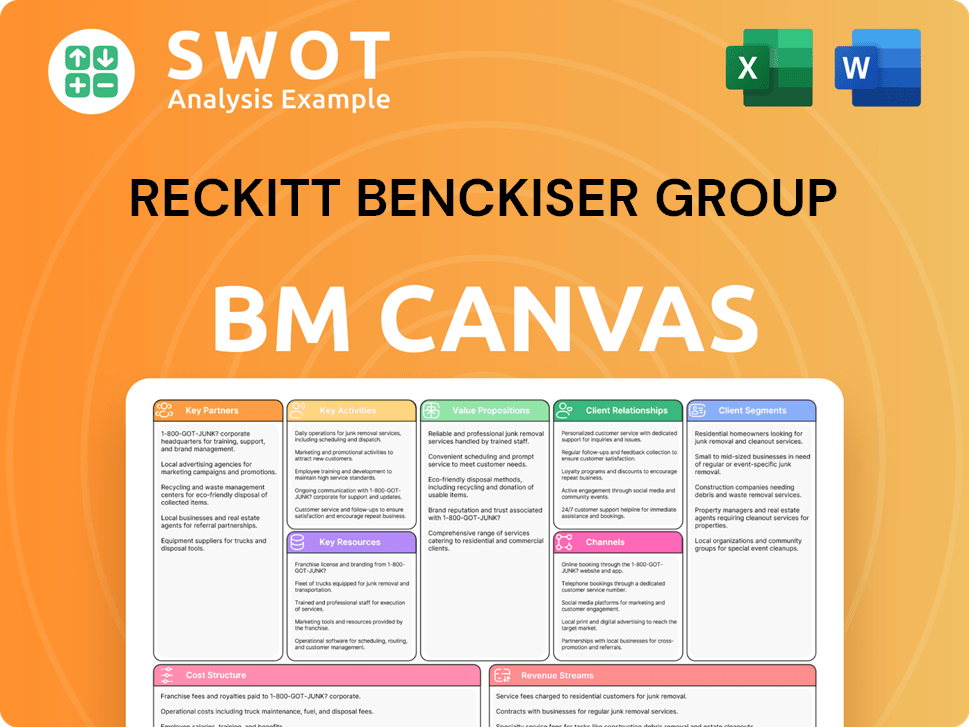
What Recent Changes Have Shaped Reckitt Benckiser Group’s Ownership Landscape?
Over the past few years, Reckitt Benckiser Group (RB Group) has been undergoing significant strategic changes, which have a direct impact on its ownership profile. In July 2024, the company announced a plan to streamline its portfolio and organizational structure to boost growth and shareholder value. This includes reorganizing into three segments: Core Reckitt, Essential Home, and Mead Johnson Nutrition, effective January 1, 2025. These moves are part of a broader strategy to adapt to evolving market conditions and maximize shareholder returns.
A key trend involves the planned divestiture of non-core assets. RB Group intends to exit its Essential Home portfolio, which generated £1.9 billion in net revenue in FY2023, by the end of 2025. Additionally, the company is exploring strategic options for its Mead Johnson Nutrition business, acquired in 2017 for $17.9 billion. As of March 2025, the sale process for the nutrition division was ongoing, attracting interest from potential buyers. Private equity firms have shown interest in acquiring Reckitt's home care assets, which are valued at over £6 billion (approximately $7.7 billion). This restructuring aims to focus the company's resources on its most profitable and strategic areas.
| Metric | Details | Date |
|---|---|---|
| Share Buyback Program | £1 billion | Completed July 2024 |
| Second Share Buyback Program | £1 billion, third tranche expected to complete | June 30, 2025 |
| Shares Bought Back (Current Program) | £815 million | April 17, 2025 |
Share buybacks have been a consistent trend, demonstrating a commitment to returning capital to shareholders. Following a £1 billion share buyback program completed in July 2024, RB Group announced a second £1 billion program to be carried out over 12 months. As of April 17, 2025, £815 million of shares had been repurchased under the current program. These actions reduce the number of outstanding shares, potentially increasing earnings per share and the proportional ownership of remaining shareholders. Leadership changes, including Kris Licht becoming CEO in May 2023 and Shannon Eisenhardt appointed CFO in March 2024, further shape the company's trajectory.
The ownership of RB Group is primarily institutional, with significant holdings by investment firms and other institutional investors. The company is publicly listed, making its ownership structure diverse.
RB Group's ownership has evolved through mergers and acquisitions. The company's history includes various changes in its shareholder base and strategic shifts.
Major shareholders of RB Group include institutional investors. The specific percentages held by each major shareholder can fluctuate based on market activity.
Yes, RB Group is a publicly traded company. This means that its shares are available for purchase on public stock exchanges.
Reckitt Benckiser Group Porter's Five Forces Analysis
- Covers All 5 Competitive Forces in Detail
- Structured for Consultants, Students, and Founders
- 100% Editable in Microsoft Word & Excel
- Instant Digital Download – Use Immediately
- Compatible with Mac & PC – Fully Unlocked
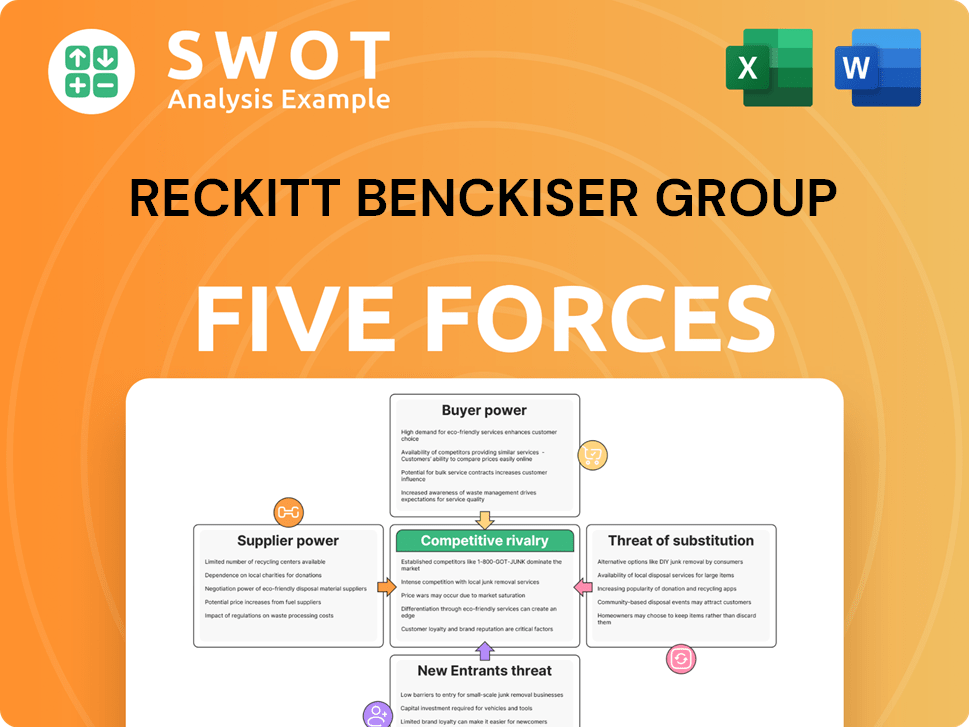
Related Blogs
- What are Mission Vision & Core Values of Reckitt Benckiser Group Company?
- What is Competitive Landscape of Reckitt Benckiser Group Company?
- What is Growth Strategy and Future Prospects of Reckitt Benckiser Group Company?
- How Does Reckitt Benckiser Group Company Work?
- What is Sales and Marketing Strategy of Reckitt Benckiser Group Company?
- What is Brief History of Reckitt Benckiser Group Company?
- What is Customer Demographics and Target Market of Reckitt Benckiser Group Company?
Disclaimer
All information, articles, and product details provided on this website are for general informational and educational purposes only. We do not claim any ownership over, nor do we intend to infringe upon, any trademarks, copyrights, logos, brand names, or other intellectual property mentioned or depicted on this site. Such intellectual property remains the property of its respective owners, and any references here are made solely for identification or informational purposes, without implying any affiliation, endorsement, or partnership.
We make no representations or warranties, express or implied, regarding the accuracy, completeness, or suitability of any content or products presented. Nothing on this website should be construed as legal, tax, investment, financial, medical, or other professional advice. In addition, no part of this site—including articles or product references—constitutes a solicitation, recommendation, endorsement, advertisement, or offer to buy or sell any securities, franchises, or other financial instruments, particularly in jurisdictions where such activity would be unlawful.
All content is of a general nature and may not address the specific circumstances of any individual or entity. It is not a substitute for professional advice or services. Any actions you take based on the information provided here are strictly at your own risk. You accept full responsibility for any decisions or outcomes arising from your use of this website and agree to release us from any liability in connection with your use of, or reliance upon, the content or products found herein.